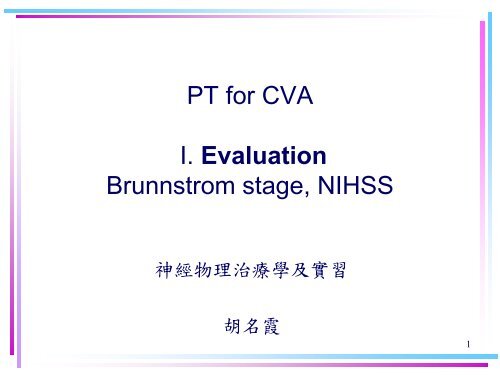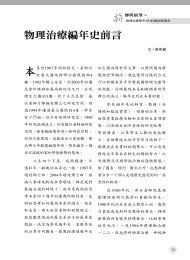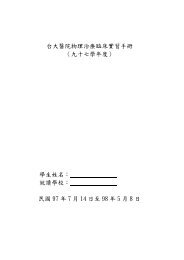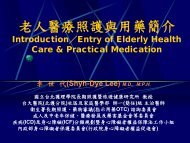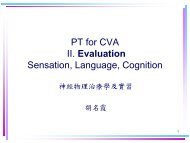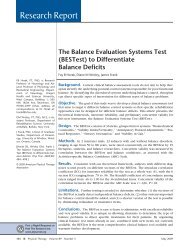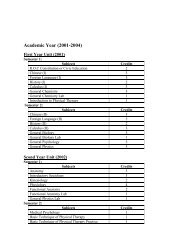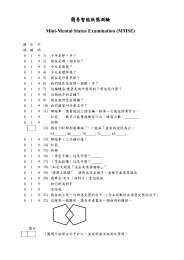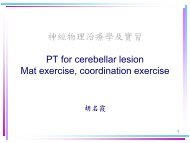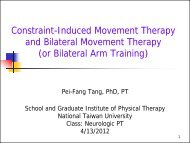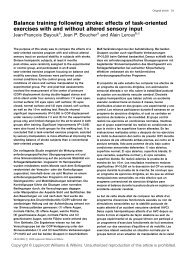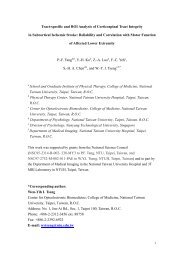PT for CVA I. Evaluation Brunnstrom stage, NIHSS
PT for CVA I. Evaluation Brunnstrom stage, NIHSS
PT for CVA I. Evaluation Brunnstrom stage, NIHSS
You also want an ePaper? Increase the reach of your titles
YUMPU automatically turns print PDFs into web optimized ePapers that Google loves.
<strong>PT</strong> <strong>for</strong> <strong>CVA</strong><br />
I. <strong>Evaluation</strong><br />
<strong>Brunnstrom</strong> <strong>stage</strong>, <strong>NIHSS</strong><br />
神 經 物 理 治 療 學 及 實 習<br />
胡 名 霞<br />
1
Biomedical selection talk<br />
• Teasell, R. (2008), "Stroke rehabilitation", in<br />
Hachinski, V. (ed.), Cerebrovascular Disease:<br />
Diagnosis, Treatment and Prevention - a<br />
prioritized approach, The Biomedical & Life<br />
Sciences Collection, Henry Stewart Talks Ltd,<br />
London (online at http://hstalks.com/bio)<br />
• Direct talk access link:<br />
http://hstalks.com/lib.php?t=HST60.2024_1_2<br />
&c=252<br />
2
中 風 - 腦 血 管 阻 塞 或 出 血<br />
(www.hmc.psu.edu/neurosu<br />
rgery/aservices/<br />
cerebralaneurysm.htm)<br />
www.biomed2.man.ac.uk/bi<br />
ology/ ns/njr/what2.html<br />
(Time, 1996.9.16, p. 48.)<br />
3
腦 中 風 ( 腦 血 管 病 變 )<br />
• Stroke<br />
• Cerebrovascular accident (<strong>CVA</strong>)<br />
• Cerebrovascular disease (CVD)<br />
• 突 然 發 生<br />
• 局 部<br />
• 非 進 行 性<br />
• 出 血 (hemorrhage) 或 缺 血 (infarction)<br />
• 腦 部 病 變<br />
• http://www.med.harvard.edu/AANLIB/home.ht<br />
ml<br />
4
相 關 名 詞<br />
• AVM: arteriovenous mal<strong>for</strong>mation<br />
• TIA: transcient ischemic attack<br />
• Young stroke:
<strong>PT</strong> diagnosis (preferred practice pattern)<br />
• 5D<br />
• Impaired motor function and sensory<br />
integrity associated with nonprogressive<br />
disorders of the central nervous<br />
system – acquired in adolescence or<br />
adulthood<br />
• Guide to <strong>PT</strong> Practice, 2nd ed, 2001.<br />
6
流 行 病 學 資 料<br />
• Largest single cause of neurological disability<br />
• 發 生 率 :<br />
– 5.95/1000; >65 歲 ,50.7/1000 ( 黃 瑞 雄 , 1997)<br />
– 55 歲 後 , 每 十 年 增 加 一 倍<br />
– 男 : 女 =1.3:1 (1.17)<br />
• 盛 行 率 : 約 15、16 萬 人<br />
• 死 亡 率 :<br />
– 我 國 第 二 大 死 因 ; >65 歲 之 第 一 死 因<br />
– 急 性 期 死 亡 率 : 17-34%<br />
– 第 一 年 死 亡 率 : 25-40%<br />
7
Recurrent Strokes<br />
• ~ 20%-40% of strokes are preceded by<br />
a TIA or non disabling stroke (Rothwell et al.<br />
Lancet Neurol 2006; 5: 323-331)<br />
• Golden Opportunity <strong>for</strong> Stroke Prevention!<br />
8
Epidemiology-etiology<br />
Cerebral infarction<br />
(thrombosis or<br />
embolism<br />
70%<br />
hemorrhage 20%<br />
(32% Taiwan,<br />
佔 死 亡 60%)<br />
unspecified 10%<br />
9
Epidemiology - Risk factors<br />
• High BP<br />
• Diabetes mellitus<br />
• Heart disease<br />
• Cigarette smoking<br />
• TIAs<br />
• Prior stroke<br />
• Cocaine use<br />
• Physical inactivity<br />
• Obesity<br />
• Excessive alcohol<br />
consumption<br />
• Elevated blood<br />
cholesterol and<br />
lipids<br />
10
Impact of Lifestyle Therapies on Blood<br />
Pressure in Hypertensive Adults<br />
Intervention Amount SBP/DBP<br />
Reduce foods with<br />
added sodium<br />
1.8g or 78 mmol/d -5.1 / -2.7<br />
Weight loss per kg lost -1.1 / -0.9<br />
Alcohol intake - 3.6 drinks/day -3.9 / -2.4<br />
Aerobic exercise 120-150 min/week -4.9 / -3.7<br />
Dietary patterns<br />
DASH diet<br />
Hypertensive<br />
Normotensive<br />
-11.4 / -5.5<br />
-3.6 / -1.8<br />
Applying the 2005 Canadian Hypertension Education Program recommendations: 3. Lifestyle modifications to prevent and treat<br />
hypertension Padwal R. et al. CMAJ ・ SE<strong>PT</strong>. 27, 2005; 173 (7) 749-751<br />
Source: 2008 CHEP Recommendations<br />
11
行 為 療 法 與 中 風 預 防 :<br />
70 萬 名 中 風 患 者 中 , 有 多 少 人 可 被 預 防 ?<br />
Hypertension<br />
360,500<br />
25,000<br />
Cholesterol<br />
146,000<br />
10,000<br />
Cigarettes<br />
Atrial Fibrillation<br />
89,500<br />
68,500<br />
5000<br />
6400<br />
Heavy Alcohol Use<br />
34,500<br />
2500<br />
0 100,000 200,000 300,000 400,000<br />
Number of Preventable Strokes*<br />
*Based on estimated 700,000 annual strokes.<br />
Gorelick PB. Arch Neurol. 1995;52:347-355.<br />
Gorelick PB. Stroke. 2002;33:862-875.<br />
12
大 腦 的 功 能<br />
大 腦<br />
思 考 學 習 動 作 感 覺<br />
聽<br />
脊 髓<br />
周 圍 神 經<br />
說<br />
讀<br />
寫<br />
13
症 狀<br />
Sensory (53%) Motor (88%)<br />
hemianopia<br />
Hemiplegia<br />
Hemiparesis<br />
mental Perceptual (32%)<br />
Dementia<br />
Hemi-neglect<br />
Emotional lability<br />
Language<br />
Aphasia (30%)<br />
Dysarthria (48%)<br />
14
Grasp<br />
reflex<br />
Neglect<br />
apraxia<br />
Hemiplegia<br />
Hemianopsia<br />
Anosognosia<br />
aphasia<br />
Locked-in<br />
syndrome<br />
Drop<br />
attacks<br />
Thalamic<br />
syndrome<br />
Cortical<br />
blindness<br />
tremor<br />
15
Framingham Heart Study 發 現 1974 年 後 , 死 亡 率 明 顯 降 低<br />
後 遺 症<br />
40%<br />
死 亡<br />
30%<br />
復 原<br />
30%<br />
16
Epidemiology-outcome<br />
• 美 國 四 百 萬 中 風 患 者 中 ,<br />
– Need assistance: 31%<br />
– Need help walking: 20%<br />
– In long-term care facilities: 16%<br />
– 7 年 後 仍 無 法 復 職 :71%<br />
18
Percent of stroke patients with plateau in motor<br />
recovery while receiving conventional rehabilitation.<br />
N=804<br />
95% get no<br />
better after<br />
11 weeks<br />
with<br />
routine<br />
care.<br />
19<br />
Jorgenson et al. Arch Phys Med Rehabil 1995
腦 中 風 後 何 時 開 始 物 理 治 療 ?<br />
• 視 個 別 狀 況 而 定<br />
• 通 常 第 一 天 開 始 物 理 治 療 預 防 併 發 症 的<br />
指 導 以 及 床 上 活 動<br />
• 起 床 活 動 (British guideline, 較 為 保 守 )<br />
– 腦 梗 塞 : 約 2-3 天<br />
– 腦 出 血 : 約 7~10-14 天<br />
20
ICF model- 動 作 障 礙 評 估<br />
strength<br />
<strong>Brunnstrom</strong><br />
<strong>stage</strong><br />
<strong>NIHSS</strong><br />
Fugl-Meyer<br />
STREAM<br />
21
肌 力 評 估<br />
22
動 作 恢 復 分 期<br />
<strong>Brunnstrom</strong>’s Stage<br />
(<strong>Brunnstrom</strong> <strong>stage</strong> excel file available.)<br />
24
<strong>Brunnstrom</strong> <strong>stage</strong> (now as part of<br />
Chedoke-McMaster stroke assessment)<br />
• Fractionation: the ability to move a single<br />
joint without simultaneously producing<br />
movements in other joints.<br />
• Synergy pattern 協 同 動 作 形 式<br />
• Associate movement 聯 合 動 作 ,<br />
associated reaction 聯 合 反 應 :the<br />
unintentional movement of one limb during the<br />
intentional movement of another limb.<br />
25
<strong>Brunnstrom</strong> <strong>stage</strong><br />
• I flaccidity<br />
• II associated movement; spasticity<br />
Typical<br />
spastic<br />
arm<br />
posture<br />
26
Resist<br />
flexion<br />
Resist<br />
extension<br />
27
Raimiste’s abduction/adduction<br />
Test position<br />
facilitation<br />
28
Associated, synergy pattern<br />
29
Extensor synergy of UE<br />
碰 右 膝<br />
30
Flexor synergy of UE<br />
手 抓 耳 後<br />
31
Flexor synergy of LE<br />
腳 彎 到 胸 前<br />
32
Extensor synergy of LE<br />
腳 往 後 踢 直<br />
33
Stage IV<br />
• Hand to sacrum<br />
• raise arm <strong>for</strong>ward to<br />
horizontal<br />
• Pronation<br />
• supination<br />
• Hip unilateral<br />
abduction<br />
• Hip flexion, acute<br />
angle<br />
• knee flexion, acute<br />
angle<br />
• Ankle flexion, acute<br />
angle<br />
• Knee extension<br />
34
Stage V<br />
• raise arm to side<br />
horizontal<br />
• Supination<br />
• Forward reach from<br />
horizontal<br />
• Raise arm over<br />
head<br />
• Ankle dorsi-plantar<br />
flexion (with knee<br />
extended)<br />
• Ankle<br />
supination/eversion<br />
(with heel on floor)<br />
• Isolated knee flexion<br />
(with hip extend in<br />
standing)<br />
35
Wrist and hand assessment<br />
36
Test with <strong>for</strong>earm supported<br />
Or, <strong>for</strong> wrist flexion with<br />
arm and hand supported in<br />
neutral position<br />
37
Speed test (<strong>for</strong> <strong>stage</strong>s IV-VI)<br />
• Lap to chin: 回 /5 秒<br />
• Lap to knee: 回 /5 秒<br />
38
<strong>NIHSS</strong> (National Institute of Health Stroke<br />
Scale)(Baird et al., 2001; Brott et al., 1989)<br />
• http://www.strokecenter.org/trials/scales/nihss<br />
.html<br />
• measured within 1 hour of the MRI scan<br />
– Very severe: >25<br />
– Severe: 15 – 25<br />
– moderate: 5 – 15<br />
– Mild: < 5 mild<br />
39
Stroke strikes F.A.S.T.<br />
• F = Face: ask the person to smile<br />
• A = Arm: ask the person to raise both arms<br />
• S = Speech: ask the person to speak a<br />
simple sentence<br />
• T = Time: go to the hospital<br />
Every minute matters!


